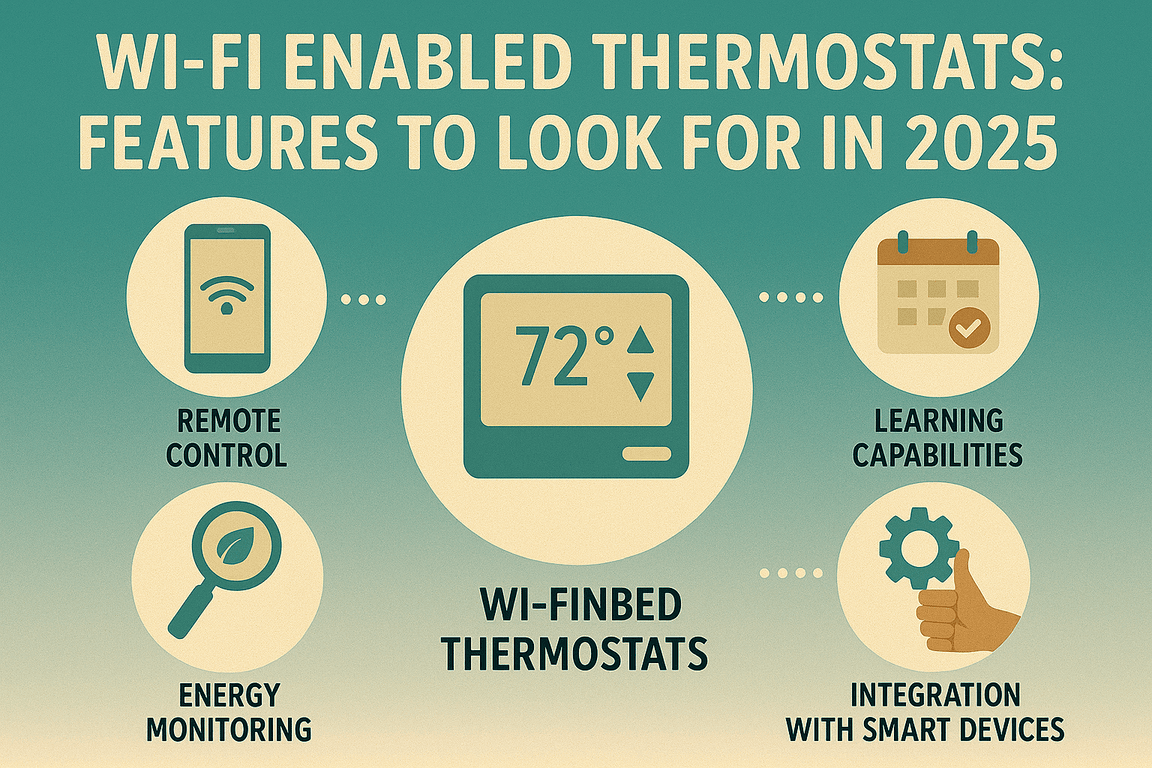As smart homes continue evolving, Wi-Fi enabled thermostats are no longer just a convenience—they’re becoming a necessity for homeowners seeking comfort, energy efficiency, and remote control. In 2025, the features of these intelligent climate control devices are smarter, more integrated, and significantly more efficient. This guide explores the most important features to look for when selecting a Wi-Fi enabled thermostat in 2025.
Why Upgrade to a Wi-Fi Enabled Thermostat in 2025?
Wi-Fi thermostats now offer far more than just temperature control. With advanced AI, enhanced IoT compatibility, and intuitive user interfaces, these devices help reduce energy bills, automate comfort, and even qualify for utility rebates. Whether you’re a homeowner or managing multiple properties, the benefits of smart temperature management are undeniable.
Top Features That Matter Most in 2025
1. Seamless Smart Home Integration
A thermostat should be more than just a standalone device. The best models in 2025 offer full integration with ecosystems like Amazon Alexa, Google Home, Apple HomeKit, and Samsung SmartThings. This ensures effortless voice control, scene programming, and automated routines. Look for models with IFTTT support to create custom rules for complete climate personalization.
2. AI-Powered Learning Capabilities
Smart thermostats today are capable of learning your daily habits. With machine learning algorithms, they adjust temperatures based on occupancy patterns, weather changes, and preferences—no manual input needed. AI allows for proactive energy savings, adjusting usage during peak hours or learning your weekend vs weekday schedules over time.
3. Geofencing Technology
This feature uses your smartphone’s location to determine whether you’re home or away. In 2025, geofencing is more accurate than ever, enabling the thermostat to automatically adjust the temperature as you leave or approach home. Energy waste is eliminated, and comfort is maximized.
4. Multi-Zone Climate Control
Modern homes demand multi-zone support. Whether you live in a two-story house or manage a larger estate, controlling different temperature zones is essential. Look for thermostats that can control multiple rooms independently—with sensors that detect occupancy and adjust accordingly.
5. Intuitive Mobile App Control
In 2025, mobile apps are not optional—they are central to the thermostat experience. The app should provide real-time insights, temperature adjustments, usage history, remote on/off scheduling, and alerts. Bonus points if the app includes AI tips for improving efficiency based on historical data.
6. Energy Reports and Eco Insights
Energy conservation is a major focus in 2025. High-end thermostats provide monthly energy reports and real-time consumption tracking. They show how your usage compares to previous months and offer actionable advice on how to save more. Look for ENERGY STAR certified models for guaranteed efficiency.
7. Voice and Gesture Recognition
Voice control is standard, but 2025 introduces gesture-based interfaces on some premium models. You can wave to change the temperature or swipe to see reports without touching the screen. These features enhance accessibility and provide a futuristic user experience.
8. Touchscreen and Design Aesthetics
Thermostats are no longer hidden on walls—they are design elements. Sleek, minimalist designs with high-resolution color touchscreens are popular in 2025. Interfaces resemble smartphones, and some even offer customizable themes to match your interior decor.
Advanced Security and Privacy Controls
In an age of increasing cyber threats, smart thermostats must protect user data. Choose a model with end-to-end encryption, two-factor authentication, and secure cloud backup. Additionally, ensure your thermostat manufacturer is transparent about data usage and privacy compliance.
Weather Forecast Integration
Thermostats in 2025 dynamically adjust temperature based on real-time weather forecasts. Anticipating a cold front or heatwave? Your thermostat prepares in advance—preheating or precooling to optimize comfort and reduce sudden spikes in usage.
Battery Backup and Power Monitoring
Ensure the thermostat supports battery backup, especially in areas prone to outages. Some advanced models also monitor HVAC performance, warning you about potential malfunctions or suggesting maintenance—preventing costly system failures.
Compatibility with HVAC Systems
Not all thermostats are universal. The top models in 2025 now support multi-stage heating and cooling systems, heat pumps, radiant floors, and even dual-fuel systems. Before purchasing, verify that the device matches your existing HVAC setup.
Installation and Setup Simplicity
Wi-Fi thermostats in 2025 are easier than ever to install. Many offer DIY-friendly installation kits, interactive guides, and QR-based setup using your phone. Others come with professional installation options if your home wiring is complex or outdated.
Remote Access and Vacation Modes
Whether you’re traveling for a weekend or spending weeks abroad, remote access is a must. Thermostats now include vacation mode, which minimizes energy use while ensuring your home is safe and comfortable upon your return.
Best Wi-Fi Thermostat Brands in 2025
While the features listed above are universal, the top thermostat brands consistently delivering in 2025 include:
- Ecobee Smart Thermostat Premium
- Nest Learning Thermostat (4th Gen)
- Honeywell Home T10 Pro
- Emerson Sensi Touch 2
- Bosch Connected Control BCC100
Choose a brand that offers frequent firmware updates, responsive support, and a strong community or user forum.
Final Thoughts: Future-Proofing Your Home with the Right Thermostat
In 2025, a Wi-Fi enabled thermostat is more than just a smart gadget—it’s a central piece of your energy-efficient, automated lifestyle. With the right model, you gain enhanced comfort, lower bills, and full remote control over your home environment. Prioritize features like AI learning, multi-zone support, smart home compatibility, and energy reporting to stay ahead of the curve.
Make a smart investment today—and let your thermostat think for you tomorrow.


